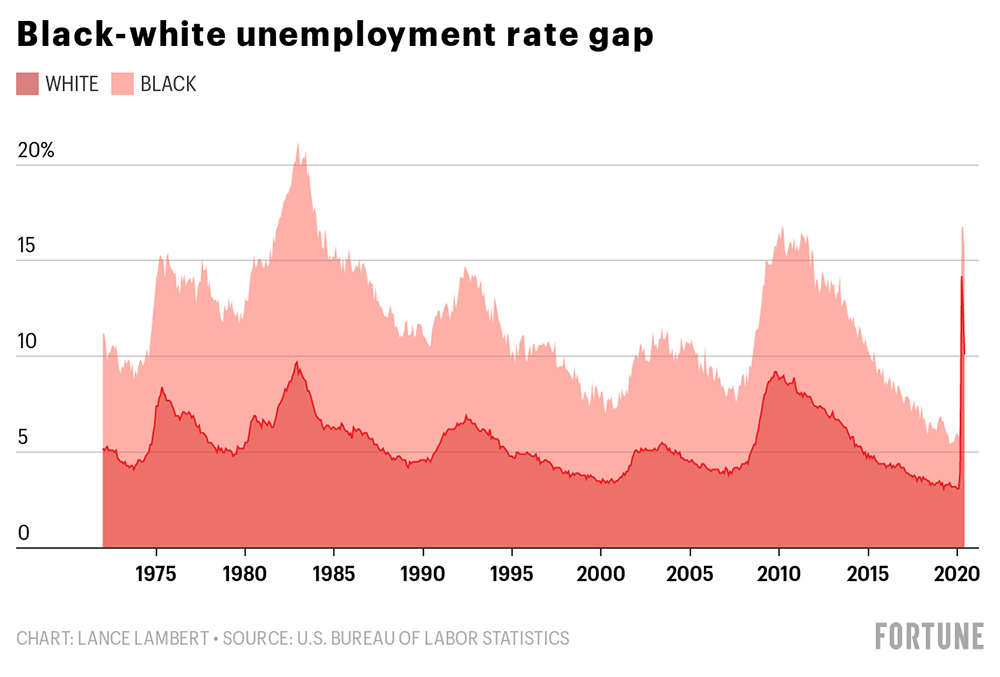上周五,隨著企業(yè)繼續(xù)重雇員工,失業(yè)率從13.3%降至11.1%。但是,特殊時(shí)期對(duì)有色人群的經(jīng)濟(jì)影響仍然比美國(guó)白人更嚴(yán)重:美國(guó)白人的失業(yè)率為10.1%,而亞裔和拉美裔的失業(yè)率分別為13.8%、14.5%。黑人的失業(yè)率最高,達(dá)到15.4%。
但是,這種種族經(jīng)濟(jì)鴻溝也凸顯了一個(gè)事實(shí),即就業(yè)市場(chǎng)一直以來(lái)并未平等對(duì)待拉美裔美國(guó)人和美國(guó)黑人。自美國(guó)勞工統(tǒng)計(jì)局(BLS)于1972年開(kāi)始計(jì)算失業(yè)率以來(lái),黑人的失業(yè)率在405個(gè)月內(nèi)或該時(shí)間段69.6%的時(shí)間內(nèi)均超過(guò)了10%。與此同時(shí),白人失業(yè)率僅在同期三個(gè)月內(nèi)或該時(shí)間段0.5%的時(shí)間內(nèi)超過(guò)兩位數(shù)。
拉美裔的失業(yè)率已有190次超過(guò)兩位數(shù),或者說(shuō)自1973年3月美國(guó)勞工統(tǒng)計(jì)局開(kāi)始計(jì)算拉美裔失業(yè)率以來(lái)33.5%的月份內(nèi)超過(guò)兩位數(shù)。自2000年美國(guó)勞工統(tǒng)計(jì)局開(kāi)始計(jì)算亞裔失業(yè)率以來(lái),亞裔工作者的失業(yè)率已三度或在該時(shí)間段1.2%的時(shí)間內(nèi)超過(guò)兩位數(shù)。

白人失業(yè)率達(dá)到兩位數(shù)的三個(gè)月均出現(xiàn)在2020年公共衛(wèi)生事件爆發(fā)之后。目前的白人11.1%失業(yè)率僅稍低于1972年以來(lái)美國(guó)黑人的平均失業(yè)率11.4%。
但是,聯(lián)邦政府每周額外發(fā)放600美元失業(yè)救濟(jì)金在某種程度上減弱了特殊時(shí)期失業(yè)人員的壓力。這項(xiàng)福利將于7月底到期。

三月以來(lái),失業(yè)問(wèn)題一直以不均衡地方式蔓延。5月20日至5月26日期間,《財(cái)富》雜志與SurveyMonkey聯(lián)合對(duì)4,109名美國(guó)成年人進(jìn)行的民意測(cè)驗(yàn),結(jié)果顯示,約有24%的黑人表示自己失去了工作,還有31%的黑人被迫減工或減薪。相比之下,白人有11%失業(yè),而28%的白人被迫減工或減薪。(財(cái)富中文網(wǎng))
譯者:Biz
上周五,隨著企業(yè)繼續(xù)重雇員工,失業(yè)率從13.3%降至11.1%。但是,特殊時(shí)期對(duì)有色人群的經(jīng)濟(jì)影響仍然比美國(guó)白人更嚴(yán)重:美國(guó)白人的失業(yè)率為10.1%,而亞裔和拉美裔的失業(yè)率分別為13.8%、14.5%。黑人的失業(yè)率最高,達(dá)到15.4%。
但是,這種種族經(jīng)濟(jì)鴻溝也凸顯了一個(gè)事實(shí),即就業(yè)市場(chǎng)一直以來(lái)并未平等對(duì)待拉美裔美國(guó)人和美國(guó)黑人。自美國(guó)勞工統(tǒng)計(jì)局(BLS)于1972年開(kāi)始計(jì)算失業(yè)率以來(lái),黑人的失業(yè)率在405個(gè)月內(nèi)或該時(shí)間段69.6%的時(shí)間內(nèi)均超過(guò)了10%。與此同時(shí),白人失業(yè)率僅在同期三個(gè)月內(nèi)或該時(shí)間段0.5%的時(shí)間內(nèi)超過(guò)兩位數(shù)。
拉美裔的失業(yè)率已有190次超過(guò)兩位數(shù),或者說(shuō)自1973年3月美國(guó)勞工統(tǒng)計(jì)局開(kāi)始計(jì)算拉美裔失業(yè)率以來(lái)33.5%的月份內(nèi)超過(guò)兩位數(shù)。自2000年美國(guó)勞工統(tǒng)計(jì)局開(kāi)始計(jì)算亞裔失業(yè)率以來(lái),亞裔工作者的失業(yè)率已三度或在該時(shí)間段1.2%的時(shí)間內(nèi)超過(guò)兩位數(shù)。
白人失業(yè)率達(dá)到兩位數(shù)的三個(gè)月均出現(xiàn)在2020年公共衛(wèi)生事件爆發(fā)之后。目前的白人11.1%失業(yè)率僅稍低于1972年以來(lái)美國(guó)黑人的平均失業(yè)率11.4%。
但是,聯(lián)邦政府每周額外發(fā)放600美元失業(yè)救濟(jì)金在某種程度上減弱了特殊時(shí)期失業(yè)人員的壓力。這項(xiàng)福利將于7月底到期。
三月以來(lái),失業(yè)問(wèn)題一直以不均衡地方式蔓延。5月20日至5月26日期間,《財(cái)富》雜志與SurveyMonkey聯(lián)合對(duì)4,109名美國(guó)成年人進(jìn)行的民意測(cè)驗(yàn),結(jié)果顯示,約有24%的黑人表示自己失去了工作,還有31%的黑人被迫減工或減薪。相比之下,白人有11%失業(yè),而28%的白人被迫減工或減薪。(財(cái)富中文網(wǎng))
譯者:Biz
On Friday the unemployment rate fell from 13.3% to 11.1% as employers continue to rehire staff. But the economic impacts of the pandemic are still hitting communities of color harder than white Americans: The jobless rate among white workers is 10.1%, compared with 13.8% for Asian workers, and 14.5% for Hispanic workers. The jobless rate is highest among Black workers at 15.4%.
But this racial economic divide also highlights the fact that the job market has always been unequal for Hispanic and Black Americans. The unemployment rate among Black workers has topped 10% in 405 months, or 69.6% of the time, since the U.S. Bureau of Labor Statistics (BLS) started calculating it in 1972. Meanwhile, the white unemployment rate has topped double digits in only three months during that same period, or 0.5% of the time.
The unemployment rate among Hispanic or Latino workers has topped double digits 190 times, or 33.5% of the months since March 1973 when the BLS started calculating that rate. And since 2000, when the BLS started calculating an unemployment rate among Asian workers, it has topped double digits on three occasions, or 1.2% of months during that period.
The three months in which the white jobless rate topped double digits all occurred since the onset of the 2020 pandemic. The current 11.1% unemployment rate is just below the average unemployment rate for Black Americans since 1972 of 11.4%.
However, workers who have lost jobs during the pandemic have felt the effects blunted somewhat by the extra $600 per week in federal unemployment benefits, which are set to expire at the end of July.
Since March, the economic pain has continued to be unevenly spread. Some 24% of Black workers say they have lost their jobs, and another 31% have seen cuts to their hours or pay, finds a Fortune-SurveyMonkey poll of 4,109 U.S. adults, conducted between May 20 and May 26. In comparison, 11% of white workers have lost their jobs, and 28% have experienced cuts to their hours or pay.






